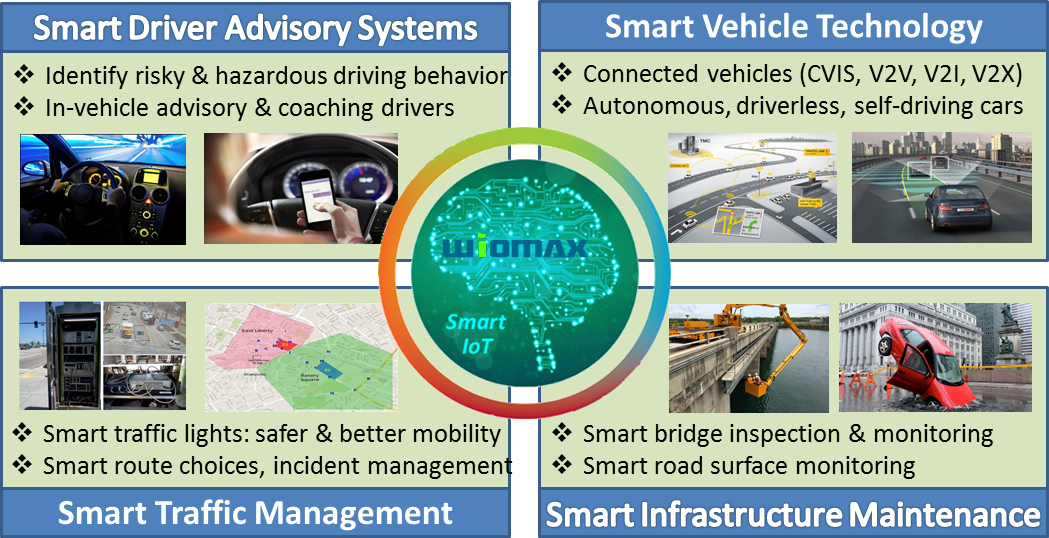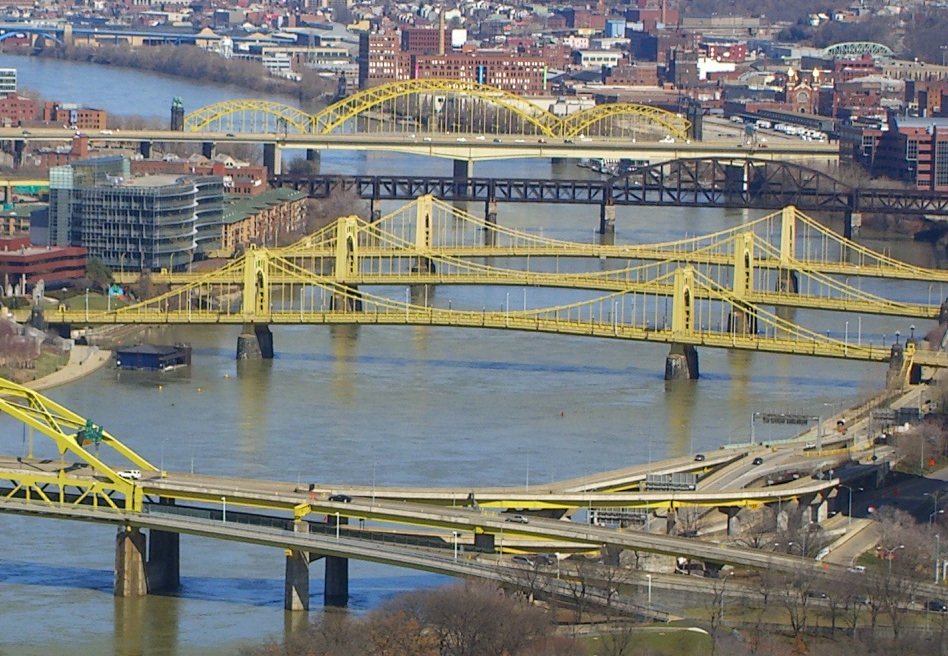The applications of the Internet of Things (IoT) have been growing dramatically in recent a few years. According to IDC, the transportation sector will be among the first to see a significant growth from the IoT, and the global IoT market in the transportation sector is expected to reach $195 billion by 2020.
The smart IoT is dramatically accelerating the pace of innovation and transforming the way of operations in transportation and infrastructure. The ubiquitous deployment of smart, connected sensors and things, combined with artificial intelligence (AI) and big data analytics, can enable us to gather insightful knowledge, make real-time and even predictive computing to help us reaching better decisions and developing better plans to improve the safety, efficiency, and reliability of smart transportation.
Here we take a look at some important applications of the IoT in intelligent transportation systems and smart cities.

The human factor continues to be one of the main contributing elements to road accidents. Reckless driving, distracted/fatigue driving and other unsafe driving habits increase the likelihood of road accidents. NHTSA conservatively estimates that approximately 25% of police-reported crashes involve some form of driver distraction and fatigue.
The smart IoT can play a proactive role in helping drivers to stay on track of safe driving habits. Through the Controller Area Network (CAN Bus) and using connected sensors, a huge amount of data about the vehicle and the driver, including measurable events such as over-correction, over-acceleration, speeding, seat belt usage, lane deviation, and drowsiness. The data can be analyzed to rate the driving quality. In-vehicle driver advisory systems can also be built to coach the driver for driving safer, and provide real-time warning notifications by detection and evaluating risks from the time series data.
Smart Car Technology: Connected and Autonomous Vehicles
In the connected vehicle technology, vehicles are equipped with one or more technologies, e.g., 4G/LTE cellular and the Dedicated Short Range Communications (DSRC), that enable the real-time interoperable communications among vehicles (V2V), infrastructure (V2I), and other things (V2X) in the proximal range. The GSM Association predicts that all vehicles will be connected by 2025. Connected vehicles can help drivers avoid crashes by providing advance warning, and reduce energy consumption and emissions, e.g., through Cooperative Adaptive Cruise Control (CACC) in fleet management.
Autonomous or self-driving cars are being designed with IoT technologies, where wireless and in-vehicle data communications connect various sensors, off-board computing, and in-vehicle operating systems. The full benefits of vehicle automation can be achieved only through a seamless connectivity. Driverless vehicles could significantly boost the user productivity, by freeing as much as 50 minutes a day per user, and might add up globally to one billion hours. Smart autonomous vehicles can also help spread out travel demand and encourage more sustainable on-demand mobility choices by bridging the connectivity in multi-modal transportation networks, and dramatically reducing the total number of vehicles on the road.
 Smart Traffic Management
Smart Traffic Management
Smart traffic management is a must necessity for smart cities, and the smart IoT in transportation and logistics is the key tech to improve cities in efficient motion.
As one of the core traffic management technologies, Surtrac smart traffic signals (invented by Xiao-Feng Xie, et al.) has been implemented through the Internet of smart intersections. On average, the system decreases travel time by 25 percent and wait time by 40 percent. Specifically, the system senses traffic flow in real time, and use artificial intelligence (AI) to dramatically reduce traffic congestion at intersections, accommodating both mobility and safety for multi-modal traffic, and share information with the network to anticipate and speed traffic flows across an entire city or region. In smart cities, the network performance and traffic demands can be measured based on big data analytics for helping make the decisions of any potential adjustments on transportation networks.
Furthermore, the data generated by sensors can be used for facilitating smart traffic incident management. As traffic incidents are identified in real time, potential impacts can be estimated through predictive computing, and thus enabling vehicles to avoid congestion by spreading out to alternate routes in the road network.
Mobile technologies today are already enabling users to perform participatory sensing, to quickly inform and be informed of traffic situations and patterns that are emerging during their commute. In a traffic incident or natural disaster situation, mobile technologies provide a simple yet powerful means for interactive exchange of information and quick coordination with other parties, such as hospitals, polices, and insurance companies.
Smart Infrastructure Maintenance
The mismanagement of transportation infrastructure, e.g., collapsed bridges or potholes in roads, might lead to unwanted congestion and fatalities.
 However, it is a very challenging task and pressing issue to provide timely maintenance for the transportation infrastructure including too many roads and bridges. It is critical to have efficient and low-cost diagnostic techniques for the infrastructure. IoT sensors can monitor and detect the structural status of roads and bridges under dynamic conditions and alert us about deficiencies for fixing them before they become less safe and more expensive to repair.
However, it is a very challenging task and pressing issue to provide timely maintenance for the transportation infrastructure including too many roads and bridges. It is critical to have efficient and low-cost diagnostic techniques for the infrastructure. IoT sensors can monitor and detect the structural status of roads and bridges under dynamic conditions and alert us about deficiencies for fixing them before they become less safe and more expensive to repair.
In USA, there are about 607,380 bridges of which 27% are deteriorating (65,605 of them are classified as “structurally deficient” and 20,808 as “fracture critical”). The 2007 collapse of the I-35W Mississippi Bridge cost the state $234 million in repairs and resulted in 13 casualties and 145 injuries. For smart bridges, low-cost wireless sensors have been designed to replace traditional methods, and embedded data processing algorithms are being adopted for automated data interrogation to better understand the response of the bridge under different conditions, and to determine when the structure is at risk or in need of repairs.
For smart road surface monitoring, IoT sensors can provide real-time data from roads to help divert the flow of traffic away from areas of hazard. Road sensors can be easily embedded under the roads so that they can effectively measure road environments, and in-vehicle mobile sensors (phones) can used to help detect road surface conditions, e.g., potholes. The data gathered by the sensors can then be analyzed to provide concerned authorities with real-time information about traffic and road conditions. The insights can help optimizing the use of limited maintenance resources and equipment, as well as predicting and alerting about hazards that may take place because of poor road conditions.
![]() By Xiao-Feng Xie, Ph.D. —— The WIOMAX SmartIoT Blog
By Xiao-Feng Xie, Ph.D. —— The WIOMAX SmartIoT Blog
The blog is also available as an updated PDF version, which can be download here:
- Key Applications of the Smart IoT to Transform Transportation Systems. Technical Report WIO-TR-18-001, WIOMAX, 2018.
![[PDF]](http://www.wiomax.com/wp-content/plugins/papercite/img/pdf.png)
![[DOI]](http://www.wiomax.com/wp-content/plugins/papercite/img/doi.png)
![[Bibtex]](http://www.wiomax.com/wp-content/plugins/papercite/img/bib.png)
@TechReport{xie2018key, title = {Key Applications of the Smart {IoT} to Transform Transportation Systems}, author = {Xiao-Feng Xie}, year = {2018}, number = {WIO-TR-18-001}, DOI = {10.13140/RG.2.2.25459.84009}, PDF = {http://www.wiomax.com/doc/report/WIO-TR-18-001.pdf}, Institution={WIOMAX}, urldate = {2016-09-20}, upddate = {2018-02-03} }

Pingback: Smart IoT in Transit Service: the Gateway to Improve Public Transportation – WIOMAX
Pingback: Internet of things – TechieWorld